 Studies on Environmental Perception during Locomotion--A Review of
Empirical Studies by the Ohno Laboratory
Studies on Environmental Perception during Locomotion--A Review of
Empirical Studies by the Ohno Laboratory |
| <Japan Architectural Review, Vol. 1, Issue 2, 194-206, March 2018> |
|
Ryuzo Ohno
|
 |
Natural and man-made landscapes cannot be seen all at once; they must be experienced in a temporal sequence.
Most previous studies, however, discuss and evaluate landscapes in terms of static scenes facing the observer. As an attempt at the scientific
investigation of the dynamic nature of perception during locomotion, this paper first discusses theoretical considerations on environmental
perception and constructs a hypothetical model. It then presents a new research tool to describe and analyze both the continuous stream of
sequential visual information received from the physical environment and the human response to it during locomotion. This is followed by a
brief review of some of the major empirical studies conducted by the Ohno Laboratory at the Tokyo Institute of Technology. Experimental studies
involving a Japanese garden, outdoor space at a university campus, and building exit areas generally support the model’s validity and tools for environmental design.
PDF⇒Full paper |
|
 Pedestrians' Mental State and Path Choice at Urban Intersections
Pedestrians' Mental State and Path Choice at Urban Intersections
|
|
<10th European Architectural Envisioning Association Conference, Envisioning Architecture, pp. 153-160, Sep. 2011. > Teruyuki Isagawa, Ryuzo OHNO
|
|
People behave according to incoming information from the environment, which is selected consciously or unconsciously based on one’s mental state. Many researchers have discussed pedestrians’ path choice behavior in a certain situation such as an emergency, exploring, etc. However, previous research has focused on a specific situation. Therefore, it is not clear how the mental state in a certain situation influences pedestrians’ path choice.
Herein we examine the influence of three different mental states, which are defined by the degree of urgency and consequence: urgent, resolute, and recreational. We conducted an experiment using a visual simulation system to present a scene of a Y-shaped intersection and asked the subject to choose a path. The stimuli were video images of 10 intersections selected from streets in Tokyo. Each video image was created by a series of photos taken at consecutive vantage points toward the intersection by a digital camera with a fish-eye lens. A virtual street was created inside a visual simulation laboratory using images projected on three screens (each 2.0 meters x 1.8 meters), which span a wide visual field. In the experiment. 32 subjects were asked to imagine that he/she was in the following four different scenarios: 1) “evacuation from a fire and smoke” (urgent state), 2) "searching for a fast-food shop" and 3) “searching for a nearby station” (resolute states), and 4) “strolling without a specific purpose” (recreational state). They were then asked to choose either the left or right route at 10 intersections for each scenario. After each choice, the subjects were asked the reason for their choice.
Path choice preference significantly varied with the situation, i.e., the mental state. A total of 1240 reasons were given, and these were categorized into three groups based on relevant phases. In the first phase, subjects demanded information such as safety, schema of a specific place, novelty. Then they tried to search for environmental cues to meet their needs such as street width, slopes, and signs in the second phase. While in the third phase information was obtained from environmental cues such as spaciousness, liveliness, mystery, and the perception of following the main route. The results indicated that subjects demand distinctly different information according to the situation.
Hence, one environment can provide different information depending on the mental state of the subject as he/she searches for environmental cues.
Paper → PDF file
|
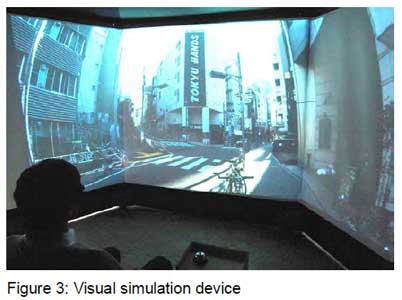 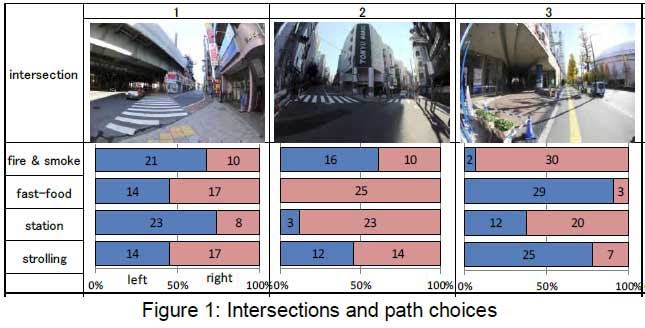 |
 Anisotropy of environmental perception caused by spatial changes during locomotion
Anisotropy of environmental perception caused by spatial changes during locomotion |
| <Journal of Environmental Psychology 30 (2010) 258-266 > |
|
Makoto Inagami and Ryuzo Ohno
|
|
Daily perception entails an immediate awareness of the environment surrounding the body. To explore
its dynamic nature during locomotion, this study tests the hypothesis that significant changes in spatial
volume induce the directional focusing (i.e., anisotropy) of environmental perception. To capture
perceptual activity in its natural state, we have attempted an approach using the feeling of visual
pressure (i.e., felt presence) caused by the surrounding environment. In the present experiment that uses
a virtual reality setup, participants were required to continuously rate their feelings while moving along
a virtual outdoor route. Their ratings were analyzed in relation to environmental measurements along
the route, such as the visible area of buildings and the horizontal extent of surrounding space. The
relationship between the ratings and measurements was explored by using two prediction models: with
and without consideration of perceptual anisotropy. The results suggested that a consideration of
anisotropy improved the prediction accuracy, thereby supporting our hypothesis.
Paper → PDF file
|
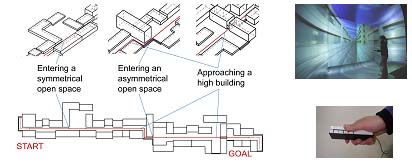  |
 Kinesthetic Sequential Memory as a Factor of Place Identification
Kinesthetic Sequential Memory as a Factor of Place Identification |
|
<Journal of Architecture, Planning and Environmental Engineering, Pp.173-178, Oct. 2002>
|
|
Ryuzo OHNO, Miki NAKAYASU and Masashi SOEDA
|
 |
| This study examines how the kinesthetic experience of walking a route affects the memory of places along the route. Each of thirty-one subjects was asked to walk three routes, which are differ in road configuration, and asked to memorize six places on each route. After this experience, the subject was asked to identify the places using three kinds of visual stimuli: a set of randomized snapshots of the scenes, CG animation of the road configurations, and a series of photos taken along the route. The result indicates that the memory of a place with the kinesthetic experience is recalled easier and is kept longer than the one without it. |
 Development of a Visual Simulation System Synchronized with Walking Motion: Development of a Visual Simulation System Synchronized with Walking Motion:
An application for a study of distance perception |
| <Proceedings of the 5th EAEA conference, pp. 24-34, 2002> |
|
Ryuzo Ohno, Megumi Katayama, Toshinori Komatsuzaki, Masashi Soeda
|
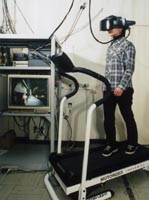 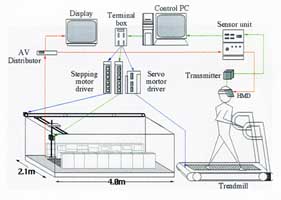
Paper → PDF
file |
Conventional
visual simulators allow observers to move in the simulated space by using a
mouse or a joy-stick without the kinesthetic feeling of motion. However, the
link between visual image and body motion is important to perceive the
environment, especially when people are walking.
A visual simulator was developed to synchronize the subject's
walking motion on the treadmill with the video image shown on a HMD. Its
validity was examined by comparing the accuracy of distance estimation with the
conventional video image without walking motion. The “distance reproduction” method was
applied to measure the perceived distance: subjects walked 25 meter in a real
setting without being told the distance, and were asked to move the same
distance in different conditions. Since the distance estimation became accurate
in the condition with the walking motion, the validity of this simulator was
secured.
The following experiment was intended to investigate the influence of
physical environmental features on perceived distance by using the simulation
system. We operated some features using a scale model of a route and examined
their influences. Subjects were asked to "walk" through a path
consisted of two spaces with different physical features, and to respond by
showing the proportion of the length of those two spaces. The result revealed
that the distance of a narrower and lower ceiling path where people perceive
clearer line perspective and faster optical flow tends to be perceived longer.
|
 A Method of Continuos Ratings for Psychological Impact While Moving Through
Exterior Space
A Method of Continuos Ratings for Psychological Impact While Moving Through
Exterior Space |
| <Toward Human Environment: Proceedings of the First International Symposium
for Environment-Behavior Research, Nanjing, China, Pp.312-317, May 2000 > |
|
Ryuzo Ohno, Rieko Tujiuchi
|
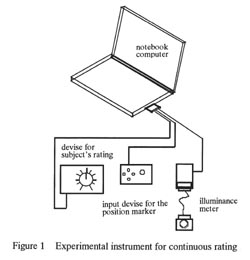 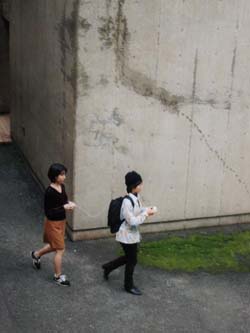
Paper → PDF file |
As a tool for environmental designers to assess the visual scenes in urban landscapes, this paper presents a method to analyze the sequential experience in a scientific manner. When we walk along a street, we unconsciously appreciate the changes in surrounding physical features that occur one after another. In this study we developed a method of recording the continuous changes in sensory impressions received from the environment. Using this nonverbal method, we conducted a series of experiments dealing with the senses of "oppression" and "release" experienced while moving through exterior space, and the validity of the method was discussed. In the experiment, sixteen subjects rated the sensory impressions along a route in a university campus, which has a variety of spaces. The result, a profile of changing sensory impressions, was examined by comparing changes in the ambient visual information of the surrounding scenes along the route. As a result, the changes of sensory impressions found to be well explained by such variables as the average distance between the observer and the surrounding surfaces, the relative spatial position of the surfaces to the observer, and the solid angle of the surrounding surfaces of buildings, ground and trees.
|
We perceive a continuous street as a series of separated spaces of different atmosphere. The present study attempts to make clear some physical features which are influential for articulation of street spaces based on the sensory stimulus information from the environment.
At first, a popular shopping street in Tokyo, Omote Sando, was chosen
as a experimental site. After strolling along the street, ten subjects
were asked to divide the street into some areas of different
atmosphere, and then they were asked to walk again along the street to
pointing out the place where the atmosphere changed.With this result,
some physical features for articulation of spaces was postulated.
Second, a program was developed to measured ambient visual information
based on the survey map of the street. The ambient visual information
included such measures as visible area of trees and spatial volume, as
well as texture of building facade. As compared the articulation point
with the significant changes in sequential profile of ambient visual
information, some primary physical features for articulation in the
street were obtained.
Third, the physical features for articulation in the street were
examined by an experiment using the space-sequence simulator, which
allows the subject go through and look around in a scale model space.
After availability of simulation for judging articulation of the space
was tested, an experiment using a series of modified model streets was
conducted to verify the relevance of the physical features.
|
|
 Effects
of emerging scenes from the occluding edges on visual attention and
evaluation of the landscape Effects
of emerging scenes from the occluding edges on visual attention and
evaluation of the landscape |
|
<J. Architect. Plann. Environ. Eng. Architectural Institute of Japan, pp.197-203,
(556), June 2002 >
Ryuzo Ohno, Azusa Udagawa, Masashi Soeda
|
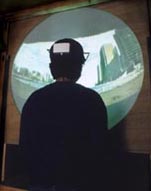
Paper → PDF file
(EDRA2005) |
|
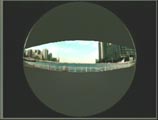 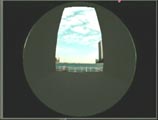 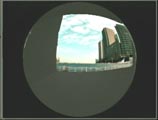 |
| The present study examines the influence of the design of exit space on visual attention of a person who is leaving a building and on his/her impression of the outside scene. An experiment using visual simulation was conducted to test the assumption that the visitor's impression of an unfamiliar scene is affected by spatial layout of the exit space of a building. Twelve movies, four kinds of CG animations of opening overlaid on three photographs of different outdoor scenes, were projected on orthographic projection screen, which enabled a subject to observe a wide angle image. After viewing each movie lasting 12 seconds, each of thirty-six subjects, who wore an eye-mark recorder, was asked to rate the overall impression of the scene using seven bipolar adjective pairs. As a result, some aspects of the subject's impressions were found to vary according to the way the scene opened up as one moved through the space. The analysis of the subjects' eye movement revealed that subjects tended to attend the area in the scene coming into sight from the occluding edges, where subjects could find more information than other areas. Combination of these results suggests that subjects' overall impression is affected by the order of appearance of partial scenes (components) in the sight, and the eye movements, which tend to follow the occluding edges that move rapidly toward the periphery. |
|
 Experiencing Japanese Gardens: Sensory Information and Behavior
Experiencing Japanese Gardens: Sensory Information and Behavior
|
| <Handbook of Japan-United States Environment-Behavior Research: Toward a Transactional Approach, Wapner, S. et al Eds., Plenum Press, New York and London, Chap.12, Pp.163-182, 1997> |
| Ryuzo OHNO, Tomohiro HATA, Miki Kondo
|
The objective of the study is to examine the hypotheses that behavior changes
at certain places in a Japanese garden, and the sensory information at
those points are responsible for these changes.
In
a circuit-style Japanese garden at Kobe, 21 subjects were asked to move
around freely along the circuit path one by one.
Each subject's movement, viewing direction and walking pace were
recorded at every 50 centimeter (one pedestrian step). In order to
analyze each subject's behavior the sensory input at a particular
visual field was measured by a computer program. This measurement was
taken at every step. By analyzing the measurements it was found that :
-one's
viewing direction was first used to acquire enough information for a
safe movement.
-then ambient information chose the frame of visual field
and
-if
one detects something within the visual field focal vision operates to
pick up detailed information from it.
|
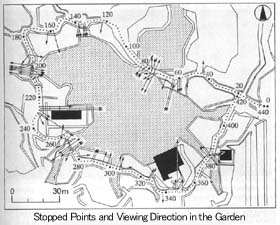 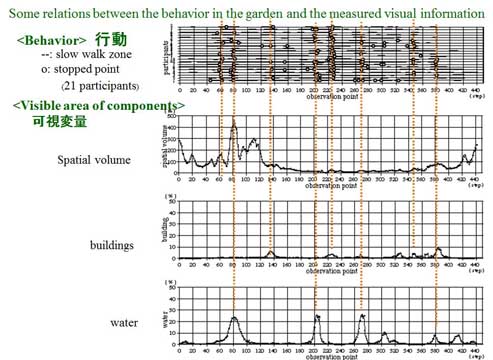
Full paper → PDF file |
|
 Measurement of the Multi-Sensory Information for Describing Sequential
Experience in the Environment: An Application to the Japanese Circuit-Style Garden
Measurement of the Multi-Sensory Information for Describing Sequential
Experience in the Environment: An Application to the Japanese Circuit-Style Garden |
|
<The Urban Experience: Proceedings of the 13th Conference of the International
Association for People-Environment Studies, E & FN SPON, pp. 425-437,
1994>
Ryuzo Ohno, Miki Kondo
|
|
Urban landscapes in
Japanese modern cities are notable for their poor visual scenes: they are often
chaotic and sometimes too monotonous where people suffer sensory overload and
sensory deprivation (Rapoport, 1980). On
the other hand the Japanese circuit-style gardens have long been appreciated
for their sequential scenes of beautiful landscapes. If we can learn from the spatial arrangements
of the garden, our urban spaces could be designed to provide pedestrians with
richer experiences and optimal levels of information. The aesthetic experience in the garden,
however, has rarelybeen analyzed based on physical or objective data because it
is difficult to explain by the characteristics of particular elements.
In the present
study, the aesthetic experience is postulated to depend on the multi-sensory
information from the environment, and a method for measuring the relevant
variables was developed. By applying the
method to circuit style Japanese gardens, the aesthetic value of which has
traditionally been recognized, the changes of the physically measurable sensory
variables as people moved through the path were objectively described. The changing profile was analyzed to reveal
the hidden order or rhythm of the sequential experience.
|
 |
Full paper → PDF file
TOPへ
|